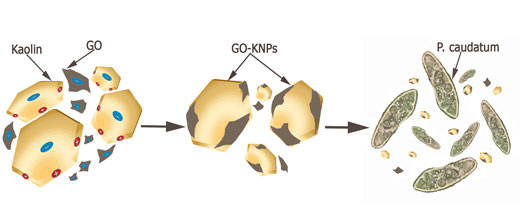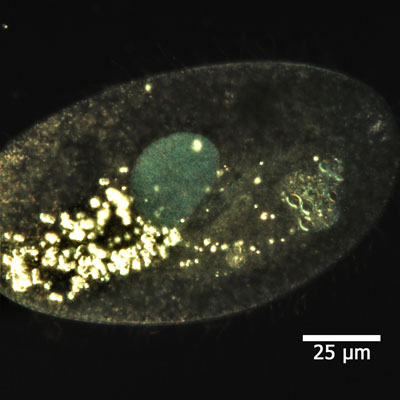| Posted: Apr 25, 2018 | |
How to eliminate a graphene oxide 'oil spill' accident |
|
| (Nanowerk Spotlight) Carbon nanomaterials, including graphene-based materials, are widely gaining popularity in practical applications of nanomanufacturing. As a result, it becomes more and more likely that the unwanted introduction of such materials into the environment may occur. In particular, aqueous habitats might be severely affected by any accidental carbon nanomaterials exposure. | |
| The environmental and health risks of one such material, graphene oxide (GO), has attracted considerable attention because of its wide-ranging applications in various field. Some studies have found that GO exhibited high toxicity to marine and freshwater algae, damaged organelles, enhanced ROS generation, induced nutrition depletion, and reduced photosynthetic pigment concentrations. | |
| Researching these potential environmental toxicity effects, scientists have found that kaolin, a cheap and abundant clay, can act as a powerful antidote to remediate the toxic effects of graphene oxide. | |
| The team, led by Professor Rawil F. Fakhrullin, Bionanotechnology Group, Institute of Fundamental Medicine and Biology, Kazan Federal University, has published their findings in Environmental Science & Technology Letters ("Kaolin Alleviates Graphene Oxide Toxicity"). | |
 |
|
| A sketch demonstrating the complexation of graphene oxide and kaolin, followed by uptake by P. caudatum protists. (Image: Rawil F. Fakhrullin) | |
| "Nanoclays, in particular kaolinite and halloysite, have been used in our laboratory as versatile platforms for drug delivery, tissue engineering and antimicrobial coatings," Fakhrullin tells Nanowerk. "We are also interested in finding out how toxic these clays and clay-based polymer composites might be. As a result, we studied extensively the biological effects of nanoclays." | |
| During these studies, the scientists used carbon nanomaterials (such as graphene oxide) as control chemicals with known toxicity. Surprisingly, they found that complexation of graphene oxide with kaolin results in pronounced alleviation of graphene oxide toxicity. | |
| The results of this study show that there might be a very simple and low-cost way to decrease the toxicity of graphene oxide. Importantly, kaolin allows reducing graphene oxide toxicity without its physical removal from the media. This is important because it appears that kaolin-based graphene oxide adsorbents may be used as an emergency direct antidote, without involving any complicated ways to remove the adsorbed carbon nanomaterial. | |
| For their experimental in vivo model, the team used Paramecium caudatum protozoan. Though this single-cell creature is simple to maintain in culture and work with, it serves as a powerful research model in nanotoxicity studies. | |
| In their experiments, they found that kaolin platelets – unlike other nanoclay used – reduces the adverse effects of graphene oxide on P. caudatum, increasing survival and growth rates, normalizing chemotaxis and galvanotaxis, improving food digestion, and reducing the number of macronucleus deformities. | |
 |
|
| Dark-field microscopy images of P. caudatum cell fed with a mixture of kaolin and graphene oxide (food vacuoles are seen inside the cell along with the nucleus having normal morphology). (Image: Rawil F. Fakhrullin) | |
| "We expect that our findings will help in developing specific adsorbents to reduce graphene oxide toxicity in case of its environmental exposure," says Fakhrullin. "We really hope that this will not be needed on a large scale, as unfortunately happens with oil spills. However, it is prudent to expect similar issues with graphene-based materials, because of the ever-increasing use of graphene industry-related research and potential applications." | |
| He adds that other applications based on these results are also quite possible, for example kaolin-graphene oxide complexes might be used instead of pure graphene oxide in several technological applications. | |
| As next steps, the researchers will study the antidote-like behavior of kaolin using other biological models, such as cell cultures and nematodes. They will also modify kaolin with different polymers to attenuate graphene oxide complexation. Finally, they plan to investigate the potential of kaolin in antidoting other carbon nanomaterials, such as carbon nanotubes. | |
 By
Michael
Berger
– Michael is author of three books by the Royal Society of Chemistry:
Nano-Society: Pushing the Boundaries of Technology,
Nanotechnology: The Future is Tiny, and
Nanoengineering: The Skills and Tools Making Technology Invisible
Copyright ©
Nanowerk LLC
By
Michael
Berger
– Michael is author of three books by the Royal Society of Chemistry:
Nano-Society: Pushing the Boundaries of Technology,
Nanotechnology: The Future is Tiny, and
Nanoengineering: The Skills and Tools Making Technology Invisible
Copyright ©
Nanowerk LLC
|
|
|
Become a Spotlight guest author! Join our large and growing group of guest contributors. Have you just published a scientific paper or have other exciting developments to share with the nanotechnology community? Here is how to publish on nanowerk.com. |
|
